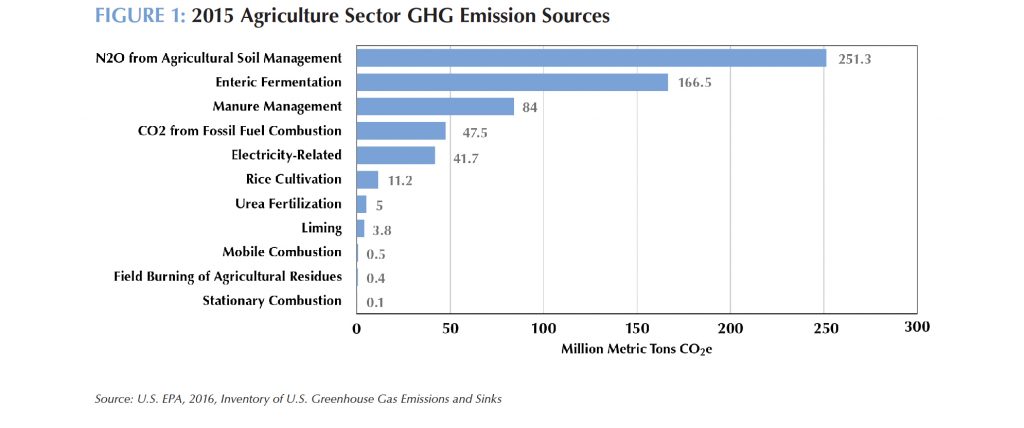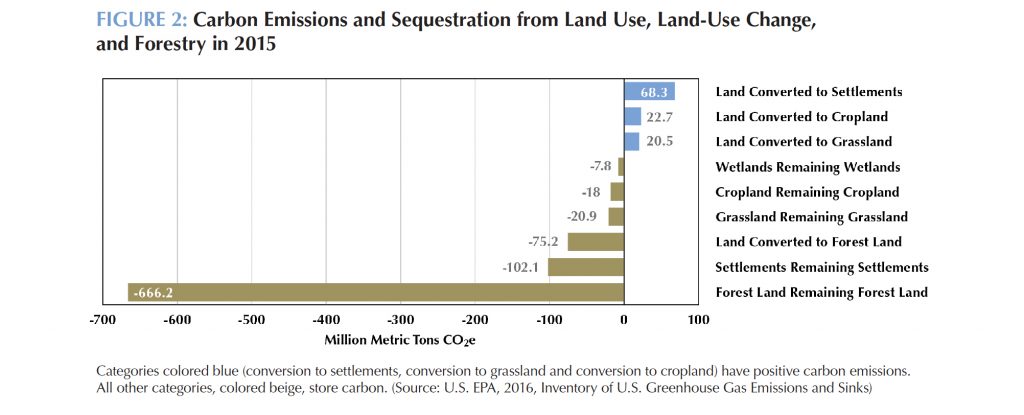
This is one in a series of briefs prepared as part of C2ES’s Climate Innovation 2050 initiative, which brings together leading companies to examine potential pathways toward substantially decarbonizing the U.S. economy. Other briefs focus on Buildings, Oil & Gas, Manufacturing, Power Generation, and Transportation. (Note: Full citations to supporting materials can be found in the pdf version of this brief.)
This brief provides an overview of emissions trends and projections, and of decarbonizaton challenges and opportunities, related to land use in the United States. Following emissions-tracking protocols, it focuses on two categories: agriculture and land use, land use change, and forestry (LULUCF). Key points include:
- Agriculture is responsible for about 8.7 percent of U.S. greenhouse gas emissions. Soil management, enteric fermentation, and manure management from livestock are the largest sources. Agricultural emissions are projected to increase 3 percent to 9 percent above 2005 levels by 2050.[1]
- Opportunities to reduce agricultural emissions include reducing fertilizer inputs, adjusting livestock feed to reduce emissions from digestive systems, and capturing methane emissions from manure. In addition, improved soil management can increase the sequestration of carbon in agricultural soils.
- Forests and other vegetated lands serve as a net greenhouse gas sink. The LULUCF “sector” absorbs about 12 percent of annual U.S. emissions, mostly in forests. Annual carbon sequestered by forests is expected to decrease by between 50 and 92 percent below 2005 levels by 2050.
- Carbon storage in the LULUCF sector can be maintained or enhanced by encouraging productive use of forested land and by reducing conversion of land to settlements and agriculture.
Overview
Agriculture
America’s 2.1 million farms generated $194.4 billion in cash crops in 2015, and $162.9 billion in animals and animal products, with exports of $133 billion.[2] The agricultural sector’s largest emissions are methane (CH4) and nitrous oxide (N2O) from livestock, manure, rice cultivation, agricultural soil management (mostly crop fertilization practices), and field burning of agricultural residues; and carbon dioxide (CO2) emissions from liming, urea fertilization and fossil fuel combustion. (The United States’ official greenhouse gas inventory counts carbon sequestered and released by croplands, grazing lands, and pastures as part of LULUCF).
LULUCF
Created as a way to track fluxes from land use and changes in land use, the LULUCF category includes forests (commercial, federally-held, and preserved), croplands, grasslands, wetlands and developed areas. Growing forests, grassland, cropland, and wetlands absorb carbon from the atmosphere, acting as sinks, and emit carbon when disturbed, converted or cleared for more intensive uses. About 33 percent of land in the United States is forestland, 37 percent is grassland (the majority of which is managed as rangeland or pasture), and 18 percent is cropland.[iii]
Emissions Trends and Projections
Agriculture
The agricultural sector was responsible for 612 million metric tons of carbon dioxide equivalent (MMtCO2e) in 2015, or 9.3 percent of total U.S. greenhouse gas emissions. Figure 1 shows the sector’s major greenhouse gas sources (excluding CO2 from soils). As of 2015, total agricultural emissions were down slightly (less than 1 percent) from 2005, but about 9 percent higher than in 1990.
Soil management is the largest source of agricultural greenhouse gas emissions, mostly in the form of nitrous oxide (N2O), which is naturally emitted by soils and fluctuates year to year with variations in weather, crop production. Most N2O emissions stem from the use of synthetic fertilizer. The next two largest greenhouse gas sources are livestock-related: enteric fermentation (the process by which methane is produced in the digestive tract of ruminant animals) and manure management. From 1990 to 2015, emissions from enteric fermentation rose 1.5 percent due to increased livestock production (although emissions per pound of meat or gallon of milk declined). Over that same period, emissions from manure management rose 64 percent due to increased swine and dairy cow production, and increased use of liquid manure management systems which are particularly emission-intensive. Emissions from fossil fuel combustion, agricultural energy consumption and electricity use largely held steady. Other sources of agricultural emissions include rice cultivation, urea fertilization, liming, and field burning.
The U.S. Department of Agriculture (USDA) projects increased agricultural emissions, mostly due to growth in population and demand. By 2050, agricultural emissions from the three largest sources (enteric fermentation, manure management and soil management) will rise 5.9 percent over 2005 levels in its reference scenario, 8.6 percent in its high scenario (which assumes higher rates of population and economic growth), and 3.2 percent in its low scenario, (which assumes lower rates of population and economic growth). Emissions from soil management are expected to increase slightly until 2020 and then level out. Emissions from enteric fermentation and manure management increase in all scenarios due to declining feed costs and rising global demand for livestock products.
 LULUCF
LULUCF
The LULUCF sector sequestered a net 759 MMtCO2e in 2015, primarily in growing forests. Figure 2 shows that the primary source of LULUCF emissions is converting land to more intensive uses including settlements, cropland, and grassland.
The primary driver of increased carbon sequestration in LULUCF in recent decades has been forest growth on remaining forestlands. Other major sources include increased carbon storage in urban trees and the conversion of land to forestland (the only form of land-use conversion that sequesters carbon). Sequestration has benefited from federally-sponsored forest management and soil conservation programs, including USDA’s Conservation Reserve Program, which currently provides farmers incentives to plant environmentally beneficial species on 24 million acres of farmland. From 1990 to 2015 annual carbon sequestration in LULUCF declined due to a decreased rate of carbon accumulation in forests and cropland and increased CO2 emissions from urban development.
In USDA’s projections, annual carbon sequestration in forestland declines dramatically in all scenarios from 855 MMtCO2e in 2010 to between 65 and 401 MMtCO2e in 2050. The USDA projections account only for conversion of forests to other uses; however, in some regions, natural forest aging, declining timber harvest, or disturbances like wildfire, weather, insects and disease will also likely reduce rates of carbon sequestration in coming years.

Decarbonization Opportunities and Challenges
Agriculture
Strategies to reduce emissions in the agricultural sector include improved practices to enhance soils as a carbon sink; technologies and materials to reduce crop-related emissions and to reduce and capture livestock emissions; and shifts in consumption patterns toward less carbon-intensive foods.
Carbon storage can be enhanced through cultivation techniques that convert atmospheric CO2 to carbon-based compounds in the soil, while also reducing erosion and the need for fertilizers and providing other benefits. These techniques include increasing the mass and quality of plant and animal inputs to soils; improving soil microbial diversity and abundance; and maintaining living plant cover on soils year-round. Breeding and choosing plants with long roots or other characteristics favoring sequestration can also enhance agricultural sinks. These practices can increase yields, but face barriers including equipment costs and the cost of measuring carbon sequestration.[i] These practices can also have the co-benefit of reducing crop water demand and improving soil moisture, which could reduce irrigation-related GHG emissions. This especially applies in areas with water shortages where pumping water grows increasingly expensive and energy-intensive.
N2O emissions can be reduced through improved management of nitrogen fertilizer use, such as better tailoring the quantity and timing of applications, improving fertilizer formulations, and applying fertilizer directly to roots. Fertilizer use can also be reduced through precision agriculture, which uses advanced technology such as sensors and data analysis to fine-tune the application of farm inputs to field conditions. Precision agriculture can also reduce fuel requirements by reducing the areas that receive agricultural inputs and the number of applications. Equipment coops and other mechanisms to share equipment could help overcome cost barriers for individual farms.
Enteric fermentation emissions from livestock can be reduced through feed management and by breeding livestock that emit less methane, including potentially through genetic modification. A number of feed additives that could reduce enteric fermentation emissions are being developed and tested for their effectiveness and long-term impacts to animal health.
Anaerobic digesters can reduce emissions from manure management by capturing and converting methane to renewable energy. Installation has been limited to large dairies that can absorb the upfront cost and capitalize on electricity generation. One study estimates that by 2050, anaerobic digesters could mitigate 151 MMtCO2e, mostly from methane abatement, but also in part from reducing electricity emissions. Improved manure collection systems could maximize biogas production and minimize emissions, and developing methods of manure collection from pasture-grazed animals could extend the use of this technology to pasture. Digesters can be designed to take in other waste such as wastewater solids, food scraps, and food production by-products to expand the amount of biogas produced, providing opportunity for cross-sector collaboration or community scale digesters.
Consumer adoption of meat and dairy alternatives could lower emissions by reducing livestock production. Food companies like Cargill, General Mills Inc., and Tyson Foods Inc. are exploring meat alternatives using plant-based materials and the potential for growing meat products from cells in labs. However, continued livestock production can play a role in lower-carbon agriculture by producing manure fertilizer and consuming crop by-products that are inedible for humans and would otherwise be farm waste.
LULUCF
Opportunities to reduce emissions and enhance carbon storage in the LULUCF sector focus on maintaining or adding forests and slowing conversion to settlement or agriculture. Increased use of wood in construction, in place of materials like steel or cement with higher carbon footprints, can incentivize private forest owners to keep land forested, thereby maintaining and enhancing forests as a net GHG sink. While wildfire is not currently a large emission source, forestry management to reduce the risk of fires would reduce future carbon releases, especially given longer fire seasons caused by climate change. Existing forests can be managed for greater carbon sequestration through fertilization, irrigation, switching to fast-growing planting stock, increasing intervals between harvests, decreasing harvest intensity, and increasing forest density. Research to prevent the spread of invasive insect species, such as the mountain pine beetle, could maintain or boost sequestration rates by reducing forest disturbance and tree mortality.
References
Bellassen, Valentin and Sebastiaan Luyssaert. “Carbon sequestration: Managing forests in uncertain times.” Nature 506, no. 7487, https://www.nature.com/news/carbon-sequestration-managing-forests-in-uncertain-times-1.14687.
Biardeau, Leopold et al. Soil Health and Carbon Sequestration in US Croplands: A Policy Analysis. Berkeley, CA: National Resources Conservation Service and Berkeley Food Institute, 2016. https://food.berkeley.edu/wp-content/uploads/2016/05/GSPPCarbon_03052016_FINAL.pdf.
Giammona, Craig. “Bill Gates-Backed Vegan Burgers Hit Mainstream with Safeway Deal,” Bloomberg, May 25, 2017, https://www.bloomberg.com/news/articles/2017-05-25/bill-gates-backed-vegan-burgers-hit-mainstream-with-safeway-deal.
Joyce, Linda A. et al. Ch. 7: Forests. Climate Change Impacts in the United States: The Third National Climate Assessment. U.S. Global Change Research Program, 2014, https://www.globalchange.gov/browse/reports/climate-change-impacts-united-states-third-national-climate-assessment-0
Peters, Adele. “Get Ready for a Meatless Meat Explosion, As Big Food Gets on Board,” Fast Company, December 18, 2017, https://www.fastcompany.com/40508181/get-ready-for-a-meatless-meat-explosion-as-big-food-gets-on-board.
U.S. Department of Agriculture, 2018, USDA Agricultural Projections to 2027, https://www.usda.gov/oce/commodity/projections/USDA_Agricultural_Projections_to_2027.pdf.
U.S. Department of Agriculture, 2016, USDA Integrated Projections for Agriculture and Forest Sector Land Use, Land-Use Change, and GHG Emissions and Removals: 2015 to 2060, https://www.google.com/url?sa=t&rct=j&q=&esrc=s&source=web&cd=1&ved=0ahUKEwjUk8T7-orcAhUBrlkKHXYcAIcQFggoMAA&url=https%3A%2F%2Fwww.usda.gov%2Foce%2Fclimate_change%2Fmitigation_technologies%2FProjections2015documentation01192016.docx&usg=AOvVaw3lnLGEigJum6OEE4GVl1jI.
U.S. Department of Agriculture Economic Research Service. “Farming and Farm Income,” last modified February 7, 2018, https://www.ers.usda.gov/data-products/ag-and-food-statistics-charting-the-essentials/farming-and-farm-income/.
U.S. Environmental Protection Agency, 2017, Inventory of U.S. Greenhouse Gas Emissions and Sinks, 1990-2015, https://www.epa.gov/ghgemissions/inventory-us-greenhouse-gas-emissions-and-sinks-1990-2015.
Wear, David N. and John W. Coulston. “From sink to source: Regional variation in U.S. forest carbon futures,” Scientific Reports 5, no. 16518 (2015), https://www.nature.com/articles/srep16518.
Zaks, David P.M. “Contribution of anaerobic digesters to emissions mitigation and electricity generation under US climate policy.” Environmental science & technology 45, no. 16 (2011), https://pubs.acs.org/doi/abs/10.1021/es104227y
